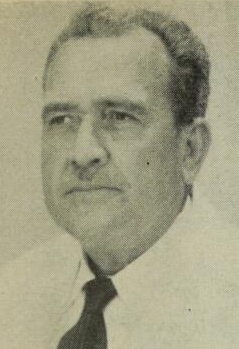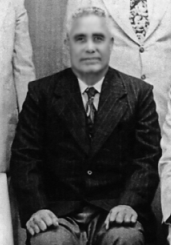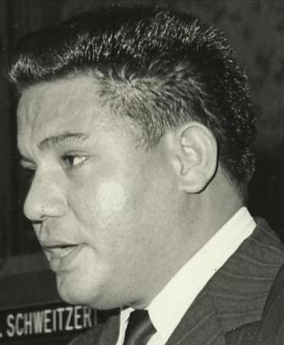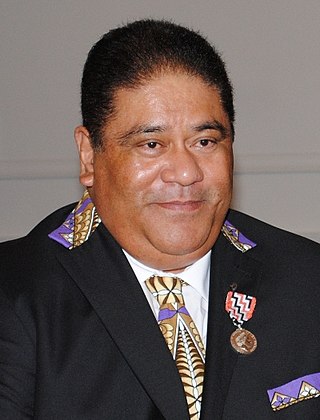 |
|---|
| Constitution |
General elections were held in Western Samoa on 13 April 1954. [1] [2]
 |
|---|
| Constitution |
General elections were held in Western Samoa on 13 April 1954. [1] [2]
The 26-member Legislative Assembly consisted of the Administrator, six civil servants, twelve Samoans appointed by the Fono of Faipule, two Fautua (Samoan chiefs) and five members directly elected by people with European status, most of whom were part-Samoan. [1]
| Candidate | Votes | % | Notes |
|---|---|---|---|
| Harry Moors | 587 | 17.01 | Re-elected |
| Peter Plowman | 488 | 14.14 | Elected |
| Fred Betham | 465 | 13.48 | Re-elected |
| Arno Max Gurau | 448 | 12.99 | Re-elected |
| Percy Morgan | 437 | 12.67 | Elected |
| Jacob Helg | 379 | 10.99 | Unseated |
| Emil Fabricius | 276 | 8.00 | |
| Edward Westbrook | 157 | 4.55 | |
| W.E. Betham | 107 | 3.10 | |
| R. Latwer | 106 | 3.07 | |
| Total | 3,450 | 100.00 | |
| Source: Pacific Islands Monthly | |||
Two candidates for the Atua seat, Tuatagaloa Leutele Te'o and Fonoti Ioane received the same number of votes. It was decided that as the incumbent Te'o should remain the representative for the constituency, whilst Ioane would be made the twelfth, non-constituency member. [1]
In 1956 the Executive Council was reorganised and a Member System introduced. To'omata Lilomaiava Tua was appointed Member for Agriculture, Tuatagaloa Leutele Te'o as Member for Education, Fonoti Ioane as Member for Health, Tualaulelei Mauri as Member for Lands, Peter Plowman as Member for Transport and Communications, and Harry Moors as Member for Works. [3]

Politics of Samoa takes place in a framework of a parliamentary representative democratic state whereby the Prime Minister of Samoa is the head of government. Existing alongside the country's Western-styled political system is the fa'amatai chiefly system of socio-political governance and organisation, central to understanding Samoa's political system.

Luamanuvao Dame Winifred Alexandra Laban is a former New Zealand politician. She served as the Member of Parliament (MP) for the Mana electorate, representing the Labour Party, and was the Labour Party's spokesperson for Pacific Island Affairs and for interfaith dialogue. Laban is the Assistant Vice-Chancellor (Pasifika) at Te Herenga Waka—Victoria University of Wellington and is a respected leader in the local Pasifika community.

Ātua is an ancient political district of Samoa, consisting of most of the eastern section of Upolu and the island Tutuila. Within Samoa’s traditional polity, Ātua is ruled by the Tui Ātua together with the group of six senior orators of Lufilufi and 13 senior matai from throughout Ātua, comprising the Fale Ātua. The fono (meeting) of Atua's rulers takes place in Lufilufi on the great malae of Lalogafu'afu'a.

The Legislative Assembly, also known as the Parliament of Samoa, is the national legislature of Samoa, seated at Apia, where the country's central administration is situated. Samoan Parliament is composed of two parts: the O le Ao o le Malo and the Legislative Assembly.

Falefā is located on the north eastern coast of Upolu island in Samoa. It was the ancient capital during the ‘Malo’ (‘government’) of Tupu Tafa'ifa (King) Fonoti. After having defeated his siblings Va'afusuaga and Samalaulu for control of Samoa, King Fonoti chose to rule from his new seat in Falefa, an honour remembered in its faalupega to this day.

Fa'amatai is the indigenous political ('chiefly') system of Samoa, central to the organization of Samoan society. It is the traditional indigenous form of governance in both Samoas, comprising American Samoa and the Independent State of Samoa. The term comprises the prefix fa'a and the word matai.

The Constitution of Samoa is a written constitution which is the supreme law in Samoa. It establishes Samoa as a parliamentary republic with a Westminster system and responsible government. It outlines the structure and powers of the Samoan government's three parts: the executive, legislature, and judiciary.

General elections were held in Western Samoa on 4 April 1964, the first since independence in 1962. All candidates ran as independents. Following the elections, Fiamē Mataʻafa Faumuina Mulinuʻu II remained Prime Minister.

General elections were held in Western Samoa on 24 February 1973. All candidates ran as independents and voting was restricted to matai and citizens of European origin, with the matai electing 45 MPs and Europeans two. Following the election, Fiame Mata'afa became Prime Minister for a second term, having previously held the office between 1959 and 1970.

General elections were held in Western Samoa on 1 November 1944.

Ulualofaiga Talamaivao Vaela'a was a Western Samoan politician and paramount chief of Fagaloa. He served as a member of the Legislative Assembly from 1954 until his death, and as Minister for Health and Minister of Justice in the 1960s.

Eugene Friedrich Paul was a Western Samoan businessman and politician. He served as a member of the Legislative Assembly in two spells between 1948 and 1961, was the first Leader of Government Business in 1958, and held the posts of Minister of Economic Development and Minister of Finance between 1957 and 1961.

Fonoti Matautia Ioane (John) Brown was a Western Samoan chief, businessman and politician. He was a member of the Legislative Assembly in two spells between 1948 and 1957, and held the portfolios of Agriculture and Health.
Afioga Tuatagaloa Leutele Te'o Satele Simaile was a Western Samoan high chief and politician. He served as a member of the Legislative Assembly from 1951 until 1970 and as Minister of Education and Minister of Justice between 1956 and 1967. He was a High Chief of Poutasi, Falefa and Safata.

Tuatagaloa Tofa Siaosi was a Western Samoan politician. He served as a member of the Legislative Assembly from 1967 until 1973 and was Minister of Finance between 1970 and 1973.
Taimalelagi Fagamalama Tuatagaloa-Leota is a Samoan Anglican archdeacon in the Anglican Church of Aotearoa, New Zealand and Polynesia. She served as the UN Observer for the Anglican Communion from 2001 to 2006. Before being ordained as a priest, she was the first lay archdeacon in the Diocese of Polynesia.

Fonotī Pati Peni Umaga is a New Zealand musician known for his compositions and musicianship as a bass guitar player, and significant contributions to the music industry, as well as his advocacy for the Pacific and Disabled communities. He works in the disability services sector.
A by-election was held in the Gagaʻifomauga 2 constituency in Samoa on 3 June 2022. It was won by Independent politician Foʻisala Lilo Tuʻu Ioane.